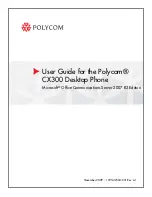
15
Timecode is numerical information that is laid down to tape alongside the footage. Each frame in a piece of
video has its own timecode.
hours seconds
01:23:48:16
minutes frames
-When shooting in PAL (British television standard), there are 25 frames per second. So the numbers in
‘frames’ will go up to 24 and then to zero.
-In NTSC (USA TV standard) there are roughly 30 frames per second.
-The tapes the Z1 uses should record an hour at the most- though in practice sometimes they run for up to 63
mins.
-You can use the ‘hours’ section of the timecode to distinguish between different tapes in the same project, if
you remember to alter the numbers each time you put in a new tape.
eg. First tape- set the timecode to 01:00:00:00
Second tape- set the timecode to 02:00:00:00
And so on. Then, when you capture the footage to Final Cut Pro, these numbers will indicate the ‘Reel
number’- and every bit of your footage will have a unique timecode. This can be invaluable if you have to re-
capture in different formats or find a badly labelled piece of footage.
-You can set the timecode to ‘free run’- which will run from the moment you switch the camera on- or
‘rec run’- which will run only when you are recording.
-Use ‘Rec run’ most of the time. ‘Free run’ is only really useful if you are recording something with a few
different cameras at once and you need to sync them up later.
SOUND
Choosing your location/ awareness of sound
Wherever you shoot, as long as you are not making a silent film, you will have to decide about sound.
What sounds do you want in your film? What sounds can you put up with? What sounds do you definitely
want to exclude?
There is no point in choosing the lip of a waterfall for a dramatic dialogue scene if the crashing water is
going to drown out the actors’ voices. It doesn’t matter how beautiful the shots would be- if the sound
doesn’t work, the audience won’t have a clue what’s going on.
Roads, aeroplanes, power lines, computers, air conditioners, fridges- all can create unacceptable levels of
background noise. Listen carefully for these things when choosing a location.
Sound can be digitally adjusted in the edit suite, but as with the picture, the more digital tweaking you
have to do the more false and tinny the sound will be by the end.
What you want is a good strong signal with no distortion- not too much background noise, but enough to
establish the atmosphere of the location.
You should test out the microphones by ear and using the sound levels on the camera before you start to
shoot- so you know what you are getting. Even if you are using a mixer, you should always do at least a
quick check on the camera headphone socket, because that is the sound that will go down onto tape.
Internal Microphone
There is a stereo microphone provided on the Z1, just between the LCD screen and the lens. It is OK, but
it will pick up lots of atmospheric sound, not to mention camera noise. You can get far better sound with
external microphones, so we do not advise you to use the internal mic for serious work.
External Microphones and mixers-
We have a few mics that are suitable to use with the Z1. Which ones you use will depend on the purpose
they need to serve.
External mics and mixers plug into the
two XLR ports
on the Z1.










































